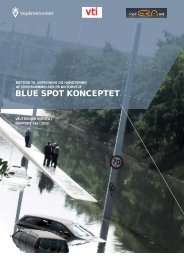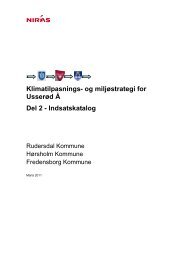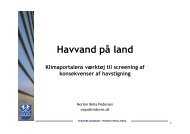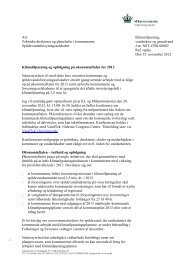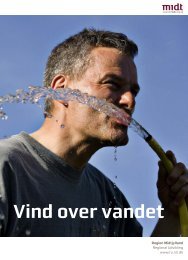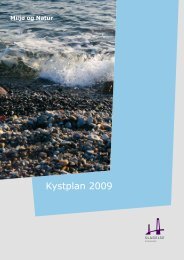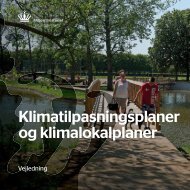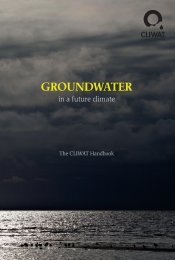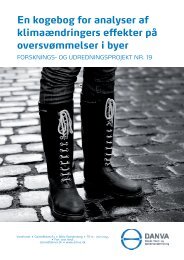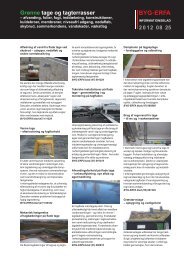Danish strategy for adaptation to a changing climate (Pdf)
Danish strategy for adaptation to a changing climate (Pdf)
Danish strategy for adaptation to a changing climate (Pdf)
You also want an ePaper? Increase the reach of your titles
YUMPU automatically turns print PDFs into web optimized ePapers that Google loves.
Au<strong>to</strong>nomous <strong>adaptation</strong> is characterised by the individual consumer's, producer's and<br />
public authorities' reactions <strong>to</strong> the physical climatic consequences within the given<br />
legislative, economic and technological framework. The planned measures can also be<br />
of very different character, ranging from new infrastructure <strong>to</strong> guidelines and in<strong>for</strong>mation.<br />
This <strong>strategy</strong> focuses on what will be attainable in the individual sec<strong>to</strong>rs within the next<br />
10 years. By "attainable" is meant that a measure should be scientifically, technically<br />
and socio-economically appropriate <strong>for</strong> implementation within the given period.<br />
In this chapter the 11 sec<strong>to</strong>rs in which <strong>climate</strong> change may be significant are reviewed.<br />
As far as possible each sec<strong>to</strong>ral section is built upon six overall parts. The first part<br />
describes the challenges facing the sec<strong>to</strong>r. Next the au<strong>to</strong>nomous <strong>adaptation</strong> already<br />
taking place is described as well as further <strong>adaptation</strong> expected within the applicable<br />
regulations and legislation. This leads <strong>to</strong> an assessment of the need <strong>to</strong> change legislation<br />
or regulations <strong>to</strong> ensure effective au<strong>to</strong>nomous and planned <strong>adaptation</strong> in the<br />
longer term. Where possible, examples are given of specific proposals <strong>for</strong> planned<br />
changes in extensions/renovations <strong>to</strong> illustrate the scope of the future <strong>adaptation</strong> ef<strong>for</strong>t.<br />
Various measures give rise <strong>to</strong> a natural need <strong>for</strong> a targeted in<strong>for</strong>mation campaign with<br />
examples intended <strong>to</strong> inspire other stakeholders facing similar challenges. Finally, every<br />
sec<strong>to</strong>r is rounded off with an evaluation of the need <strong>for</strong> more detailed socio-economic<br />
analysis <strong>to</strong> quantify the consequences of the suggested measures. These analyses will<br />
constitute an important part of the future decision basis <strong>for</strong> implementing measures, the<br />
main purpose of which is <strong>climate</strong> change <strong>adaptation</strong>.<br />
Adaptation is a long-term process marked by uncertainty regarding what consequences<br />
<strong>climate</strong> change will bring, and how soon. At present there is no available basis, including<br />
socio-economic analyses, <strong>for</strong> decision-making on cross-sec<strong>to</strong>ral government measures<br />
in this area.<br />
3.1 Coastal management, dikes, ports etc.<br />
Higher sea levels and stronger s<strong>to</strong>rms with higher s<strong>to</strong>rm surges are expected. This<br />
means a higher risk of flooding and more erosion along many stretches of coast. Since<br />
the strongest s<strong>to</strong>rms will come from the west, the increased risk of flooding and erosion<br />
will vary widely from the west coast of Jutland, <strong>to</strong> the Wadden Sea tidal areas and <strong>to</strong> the<br />
interior shores of <strong>Danish</strong> waters. Moreover, new waterfront construction, port-related<br />
operations and sanding up of harbour entrances will pose special problems. Cities located<br />
at river mouths at the bot<strong>to</strong>m of fjords may face a very complex set of problems,<br />
since they can be under pressure from higher sea levels, increased precipitation and<br />
runoff, as well as changes in groundwater levels.<br />
The opportunities <strong>for</strong> continuous <strong>climate</strong> change <strong>adaptation</strong> are generally good, and in<br />
some areas are already underway. Where coastal erosion is countered by regular beach<br />
nourishment with sand, individual site owners just increase the amount of sand <strong>to</strong><br />
correspond <strong>to</strong> actual needs. The same applies <strong>to</strong> channel dredging, where the amount<br />
dredged can be increased as required. Also in the case of rein<strong>for</strong>cing dikes/dunes or<br />
adapting harbour installations and ferry berths, which are relatively simple constructions,<br />
it will be possible <strong>for</strong> individual owners <strong>to</strong> adapt <strong>to</strong> ongoing <strong>climate</strong> changes.<br />
18



